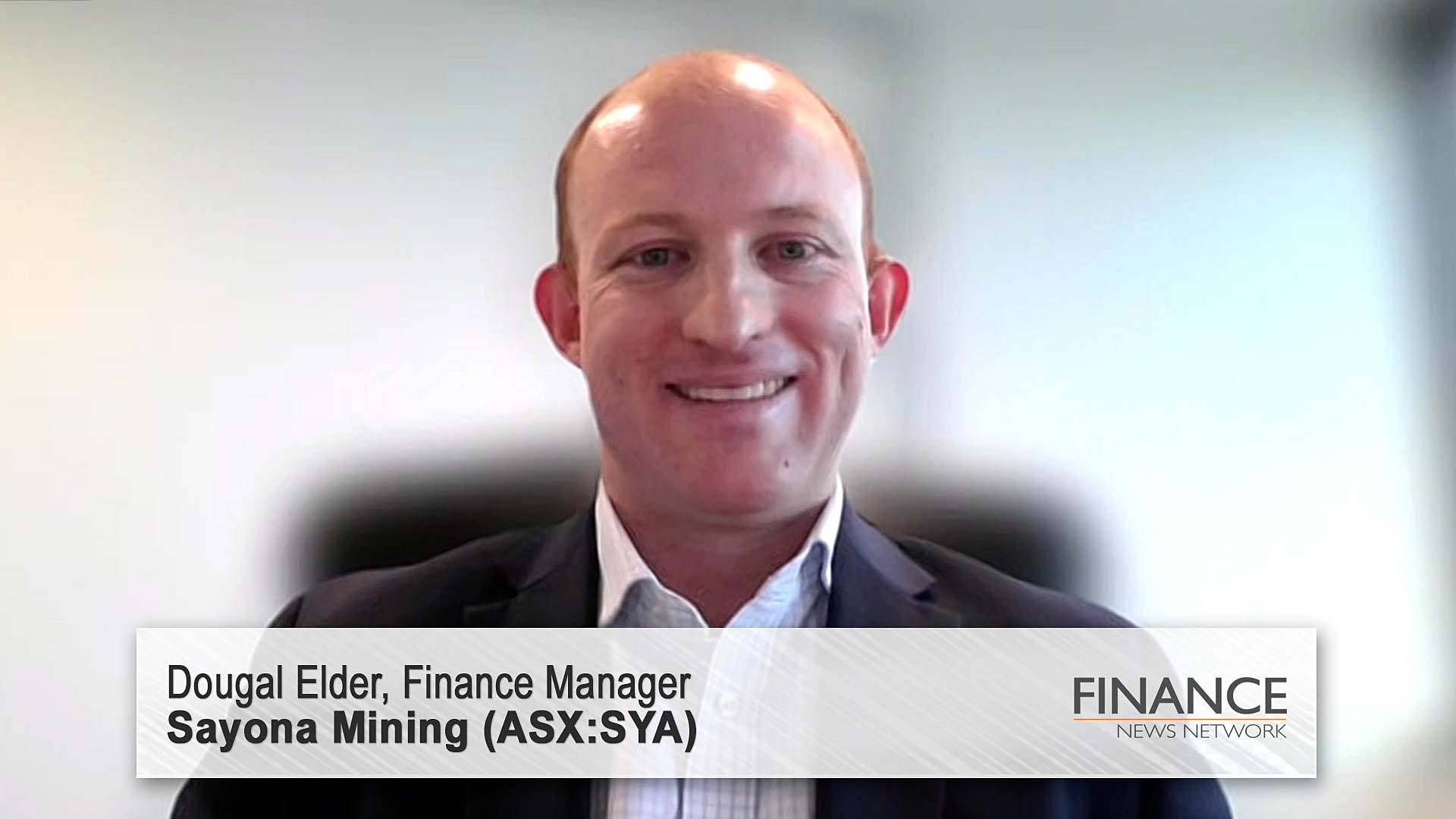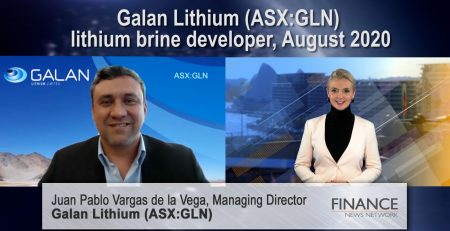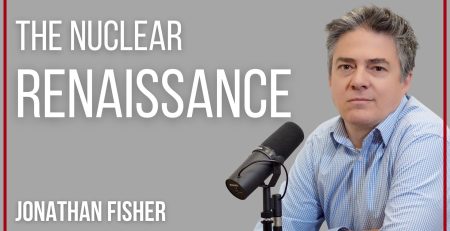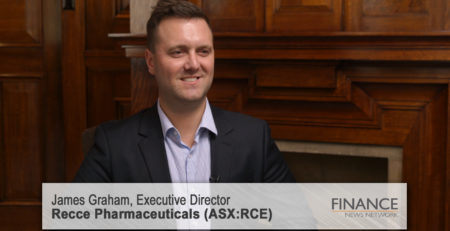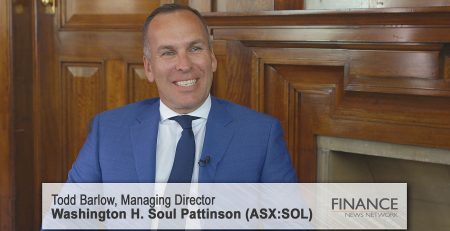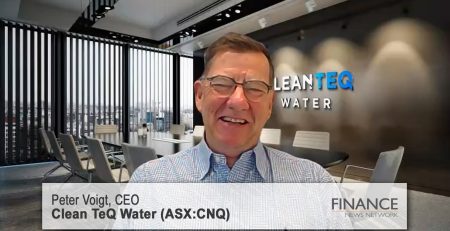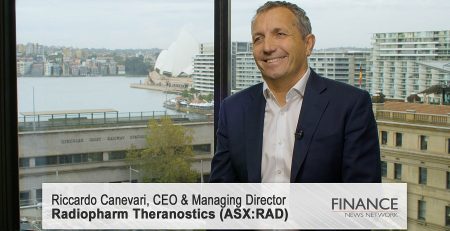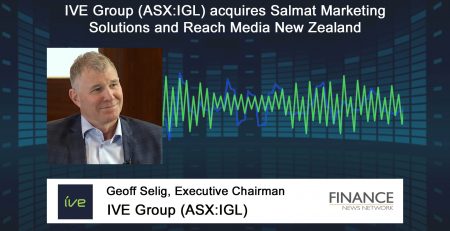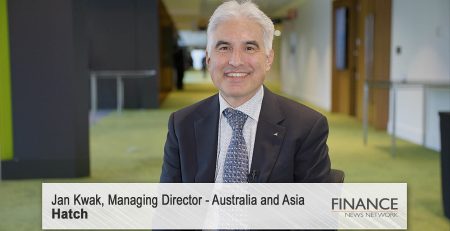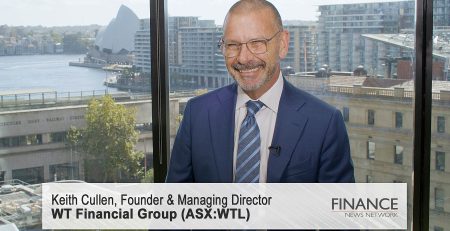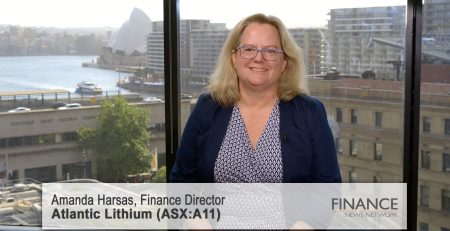Sayona Mining (ASX:SYA) discusses DFS upgrade and lithium resource expansion
Sayona Mining Limited (ASX:SYA) Finance Manager Dougal Elder discusses the release of the DFS for the North American Lithium Project, the increase in the Moblan resources, funding and timeline.
Tim McGowen: We're talking today with Sayona Mining (ASX:SYA). It's an emerging leader in the supply of lithium for North America's electrification. It has an ASX code of "SYA" and a market cap of $1.7bn. We're joined by Dougal Elder, who's the company Finance Manager. Dougal, welcome back to the network. Thanks for your time.
Dougal Elder: Thanks for having us, Tim.
Tim McGowen: Dougal, congratulations on releasing the DFS announcement on Friday night for the now-producing North American Lithium Project — referred to, of course, affectionately as "NAL". Now, on Friday, you've announced an almost doubling of your NPV on a Canadian dollar basis, and that's led to an Australian NPV valuation of about $2.2bn. There's been some changes as to how the project might look since last year's PFS was released. With all those changes in mind, can you run us through the factors driving the substantial increase in the value at NAL?
Dougal Elder: Yeah, thanks, Tim. And I think the first point that I might make is, you know, NAL is now a $2bn valuation operation, and that's a plant that we bought for $100m only two years ago. So, significant value has been delivered to Sayona through our hub-and-spoke strategy. And I think that's probably the first point to make. The factors driving the valuation uplift for NAL are numerous, and they're primarily operational factors. So, we start with production. The production run rate for NAL in the near term will be 226,000 tonnes per annum. And that's really around maximising tonnes out of the plant whilst the spodumene prices are at a very high level. So, we are going to produce and sell a 5.4 per cent grade product, and that's really around maximising margin to the joint venture to allow us to get to that 226,000 tonne run rate.
The life of mine production for NAL is 190,000 tonnes over the life, the 20-year life, which is a 16 per cent increase over and above the PFS. So, again, you know, more tonnes out of the plant over its life, a significant contributor to the valuation uplift. The plant also is looking for higher recoveries until the commencement of downstream operations. So, we're looking at recoveries in excess of 70 per cent, so it's between 70 and 72 per cent. And that's a function of, you know, we've lowered the grade to drive out tones, but also maximised recoveries to ensure that we can deliver the greatest economic margin to the joint venture. We've also looked at improving grades. So, the reserve and the resource has fallen at both NAL, and the reserve has fallen at Authier, but that's a function of significantly increasing the grades of those two ore bodies. And that's part of our strategy around mining a higher-grade deposit, to increase the grades through the NAL concentrator to maximise recoveries and maximise spodumene concentrate that is available for sale.
So, I think, all in all, it's a very positive story. More tonnes, better grade, higher recoveries. And I think, you know, the decrease in the mine life and the lower reserves because tonnes have moved from indicated to inferred. We're very confident that we'll pull those back into indicated as a result of the part of 50,000m drill campaign that is already underway at the Abitibi Hub. So, we're very confident that the lithium is still there, and we're going to pull that back through the drill program this year, starting with a 16,000m program to convert those inferred resources back to indicated over coming months.
Tim McGowen: What can we expect from the NAL project in 2023 and 2024? And when and how will the nearby Authier be developed, and what is the status with permitting here?
Dougal Elder: The primary focus for us is about de-risking the NAL concentrator, and we've taken a number of measures to deliver this. There's a significant stockpile of ore on the run of mine stockpile today. Over 200,000 tonnes is there today. And that's really about de-risking the feed intake to the crushing circuit to allow the NAL concentrator just to run at maximum capacity. So, we've taken steps to de-risk the mining operation and build that stockpile. And I think the focus for us over the balance of this year is to ramp NAL aggressively to its production run rate of 226,000 tonnes. We think we'll get there by around October of this year, Q4, and then the challenge is to hold that level moving forward once we get to that rate. So, that's the focus for this year.
You mentioned Authier. So, Authier is part of the hub-and-spoke strategy for the Abitibi Hub, and very important to the NAL concentrator over its life of mine. We've taken the decision to undertake a public consultation process there called a BAP. That's a voluntary decision, and that was really around providing the local community and stakeholders in the Abitibi region the opportunity to provide their opinions on the proposed Authier project, which has undergone a far more comprehensive environmental assessment. So, you know, we wanted to maintain our social licence in that region, and we think it's very important to keep the community on board in relation to that project. So, that public consultation process will kick off later in the year, and we are anticipating that the public decrees will be issued prior to the middle of next year, with first ore production around the middle of next year delivered to NAL.
So, I guess the focus is de-risking NAL, bringing Authier online within the next 18 months or so. And then the third thing is we're undertaking an extensive drilling program program across the NAL and Vallée Lithium projects, and there's a number of reasons for this. I mentioned the part of the reserves that have fallen from indicated back to inferred. Part of that program is to bring those back into indicated, which we're very confident that the lithium is still there and it's just a matter of getting that drilling done within the pit shell to move those inferred resources back into indicated. There's another around 30,000m of exploration drilling along strike or along trend from the NAL pit. That's to the northwest and to the southeast, so that's pure upside to the current model. And then the third part to the drilling program is drilling across the Vallée Lithium Project, which is part of our $4m commitment this year to own a 25 per cent interest in the Vallée Lithium Project.
So, lots of drilling this year at the NAL project to increase the confidence around the measured and indicated part of the reserves, but also potentially grow the resource base there. And I should note that all of that work is fully funded. We raised money through the Canadian flow-through share scheme a few months back. That was to basically underwrite all of this work that we knew that was upcoming. So, a fully funded exploration program, drilling at speed to not only increase our confidence in the resource and reserve model, but also potentially to try and grow the size of our resource base at the Abitibi Hub.
Tim McGowen: And, Dougal, we've got some questions on funding. But, first up, the lithium carbonate refinery near NAL is kind of partially constructed, with a PFS for the lithium refinery due out shortly. Can you paint a picture of what becoming Canada's first vertically integrated lithium developer might look like, and how will that project be funded?
Dougal Elder: That's a great point, Tim. And I think, you know, that's the really key message with the NAL carbonate plant. It's a partially constructed carbonate plant that we purchased two years ago from the Quebec government as part of the NAL acquisition, and if we can get that into operation by the end of 2026, NAL would be the first and only integrated lithium chemical producer in North America for supply into North America. So, I think that's a very significant opportunity, not only for Sayona together with our partners at Piedmont Lithium (ASX:PLL), but also for the province of Quebec, you know, to be the primary and a significant supplier of lithium chemicals sourced from North America into North America. So, I think that's a very substantial opportunity that awaits, and we're looking to progress that rapidly. As you mentioned, there's a PFS underway for the carbonate facility. That's due back at the end of April. That work has been undertaken by Hatch, and they've been studying the carbonate plant for a number of years, so they've got a very good understanding of that facility. We're expecting a capital cost of around US$300m to complete that plant. And just to put that into context, the single biggest piece of equipment that is required is the crystalliser, which is around $75m. So, you know, the PFS will obviously give us detail around the economics, timelines and capital costs, but we're very excited with the opportunity and we could expect some, you know, very promising and favourable NPVs relating to the economics of capturing higher value-added margins from downstream refining onsite at NAL.
Tim McGowen: And, of course, Dougal, you released a combined DFS for Authier and NAL. What was the importance of kind of releasing this in a combination?
Dougal Elder: I think it speaks to the value of the hub-and-spoke strategy that Sayona implemented when we purchased North American Lithium two years ago together with our partners, Piedmont Lithium. You know, I think having Authier there as a satellite deposit to support the ore body at NAL and the additional steps that we've taken to have the earning right to earn into a 51 per cent interest in the Vallée joint venture, which is the neighbor to NAL, is really about growing the resource space around the NAL concentrator to provide more tonnes at a better grade for a longer life of mine, which, ultimately, potentially, will end up being translated into more downstream lithium chemicals from the NAL concentrator and carbonate plants.
So, I think the other unique opportunity that NAL offers is that, if the joint venture proceeds with completing the construction of the carbonate plant, it represents an opportunity to take ore from 1 per cent in the ground to a 99 per cent lithium chemical, all within two kilometres of the original ore source at the lowest carbon footprint in North America. So, not only is it favourable on a economic perspective, but also from a carbon footprint perspective. NAL's integrated downstream operation provides a really fantastic opportunity for Quebec and North America.
Tim McGowen: And, Dougal, you've been busy, let's talk about today's announcement. You've released a massive increase in your resource at Moblan, where you're in partnership, of course, with the Canadian government and where you plan to create a vertically integrated lithium hydroxide hub. What are the strategic advantages of that? And, once again, how might that be funded?
Dougal Elder: Yeah, I think that's a really good point, Tim, about, you know, the partnership that we have at both our hubs. So, we have a partnership model with Piedmont Lithium at NAL, the Abitibi Hub. That's a 75 per cent Sayona, 25 per cent Piedmont partnership. And the partnership we have in the north with Moblan is with the Quebec government. Sayona has 60 per cent of that project and the government has 40 per cent. And I think, talking to Moblan specifically, we think it's very strategically important to have the government as a partner in that project because Moblan represents an opportunity that is significantly larger than NAL. It could be multiples larger than NAL in terms of potential production capacity. So, having the government there as a partner with a vested economic interest in the asset aligns us with the government in terms of rapidly moving through the permitting process, but also with the potential funding equation.
And I think, when we talk to funding around Moblan, we are looking at a puzzle where you're potentially looking at contributions from the JV partners, being Sayona and the government, you're potentially looking at debt finance, potentially contribution from governments, and also, you know, there may be offtakers or OEM or car-makers in the mix as well, and there's various mechanisms around that. So, that's a piece of work that we are working through at the moment, and we may have news on that later in the year. But certainly I think the opportunity with Moblan is significant. We've already demonstrated with the news today that Moblan is one of the largest single deposits in North America. It's very high grade, it's low strip, a very favourable ore body, and we're certainly very excited about the opportunity to further grow that resource base and increase the grade as we move through this year.
Tim McGowen: And in regards to that resource base, you're drilling a further 60,000m, I understand, in 2023. Is this activity mainly infill drilling to better define the deposit or are you still looking to increase the resource further?
Dougal Elder: Yeah, it's both. So, the infill drilling will be focused on moving part of the resource base that's in the inferred category back into indicated, similar to the drilling that we're doing at NAL this year. But I think the upside opportunity is about connecting the pegmatites, the main and inter pegmatites, to the Moleon in the east. There's a patch of ground there where we're looking to define, you know, the extent of the mineralisation down depth, but also to connect the ore bodies that we've already established. So, I think we're looking to further grow that resource base within the Moblan property this year and, as you mentioned, a 60,000m drill program that is already underway, and that'll be progressing through this year.
I think the other point to note is that we still have a significant portion of ground potentially, particularly to the east of Moblan, which is the Troilus claims that we acquired last year. The Moleon pegmatites that we have established with the resource upgrade today sit right on the eastern boundary with Troilus. So, there's the potential that that mineralisation continues east into those claims, which are completely unexplored for lithium. So, the regional opportunity in the Northern Hub we think is significant, but our focus this year is really around, you know, converting those resources on the Moblan property, looking for potential exploration upside to grow that resource base on Moblan, and then we'll be moving outward to, you know, further explore the regional opportunity, starting with the Troilus claims moving forward.
Tim McGowen: And also, what is the resource target required to meet your JV's ambitions at the Northern Hub?
Dougal Elder: So, we've said that we've got an ambition to produce 100,000 tonnes of lithium hydroxide from the Northern Hub by 2030, which on any metric is, you know, very significant production — probably one of the largest chemical production facilities in the world. And I think, you know, to get there, we are going to need a fairly substantial spodumene concentrate production rate supported by a very large resource base. So, we've already established a resource at Moblan today of 51 million tonnes at a grade of 1.31 per cent. We had an ambition to achieve a resource of 60 million tonnes, so we're pretty close. I think really what we need to be looking at is in excess of 100 million tonnes over time. So, we've made a good start with the announcement today, but obviously we've got more work to do with the drilling program this year, and I think we'll get there in a number of steps. So, I think Moblan, you know, has characteristics where it could be certainly a tier one asset in terms of, you know, world-class lithium deposits. So, we're looking to rapidly progress the development of that and to get a resource base that is big enough to supply our chemical ambition of 100,000 tonnes of lithium hydroxide by 2030.
Tim McGowen: And, Dougal, de-risking your portfolio will be key moving forward. Can you talk about the drilling activity you've got planned? It seems like a lot.
Dougal Elder: It is, yeah. I think, you know, two themes that we talked about at the start of this year was de-risking and growth. De-risking was really around NAL, and we've taken a number of steps to do this through the $100m of capital that we've invested to improve the existing infrastructure at NAL. That's all in place today and operating, for the operational portion of the capital. We've also taken other steps at NAL to de-risk the plant through mining operations, building a significant stockpile of inventory on the run of mine stockpile. And then, you know, Authier and potentially down the road the Vallée Project will also form part of that puzzle to really de-risk the mining operations in the Abitibi Hub and allowing the NAL concentrator to meet its production ambitions.
In terms of the drilling activity, Sayona's got plans to do over 110,000m of drilling in Quebec this year, which is on any measure a massive drill program. We've got 50,000m planned at the Abitibi Hub, which is around converting inferred reserves back to indicated, but also growing the resource base in the Abitibi Hub. And in the north, similar to Abitibi, Moblan is around converting a portion of the inferred resources back to indicated, but then also looking to grow that resource base even further and drive the grades up even higher, which, you know, certainly with the results that we've seen so far, we're very encouraged by the opportunity in terms of the geology that Moblan represents. So, I think, you know, de-risking NAL, but then growing both the Abitibi Hub and the Northern Hub are two big priorities for Sayona this year.
Tim McGowen: And, Dougal, you seem to have numerous feasibility studies due over the next six months. Can you run us through the key catalysts the market can expect?
Dougal Elder: I think we've obviously over this weekend delivered two major announcements through the Abitibi or NAL-Authier DFS, which has shown a doubling of the NPV for that project, and then the upgrade of the Moblan resource today, which is a resource of 51 million tonnes. So, I think there's two key milestones that we've delivered today. Moving forward, we've got a number of news flow items to look forward to. We start with NAL. We have a pending offtake agreement for half of NAL's production capacity that is currently un-contracted. We'll have news on that in the next month or so. Then we move forward to July, which we're looking forward to the first shipment and, more importantly, first revenue to the joint venture. So, we think that that'll be a major milestone for North American Lithium and the NAL joint venture.
As we go downstream at NAL, we have a PFS for the partially constructed carbonate facility due at the end of April, and then we move forward to hopefully a DFS by the end of the year, subject to the board review of the PFS. So, NAL, there's a number of news flow items working for both the spodumene concentrate production, but also the downstream. And then we swing north to Moblan. We've obviously got the resource that we announced today. We look forward to a PFS for Moblan for the construction of a mining concentrator at the end of May, so next month, and then a DFS at the end of October. So, a number of potential catalysts there as we move through the year for both our Northern and our Southern Hubs, so there's lots of exciting news to look forward to.
Tim McGowen: Dougal Elder, thank you for your time.
Dougal Elder: Thanks, Tim.
Ends
Copyright 2023 – Finance News Network
Source: Finance News Network

